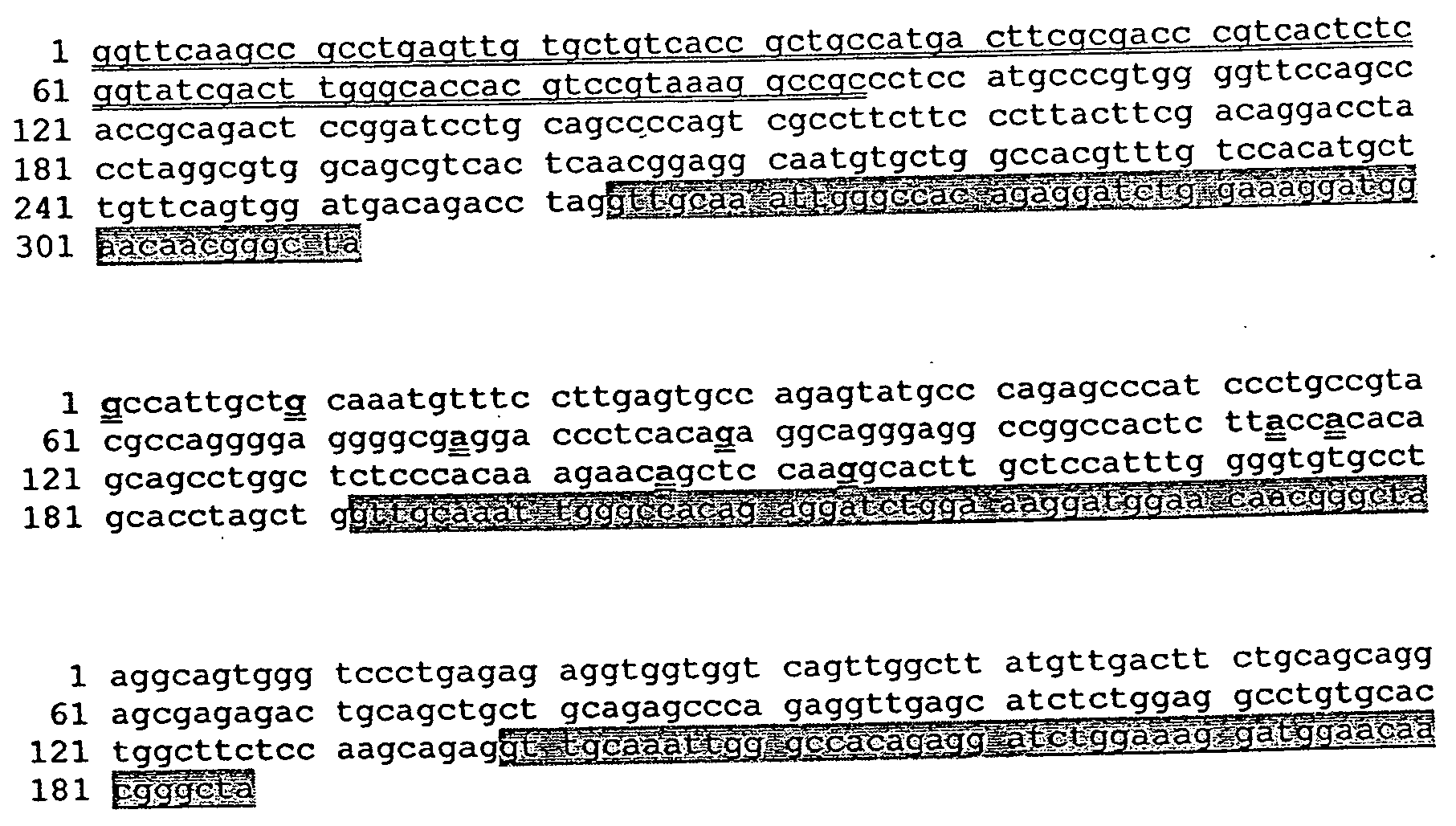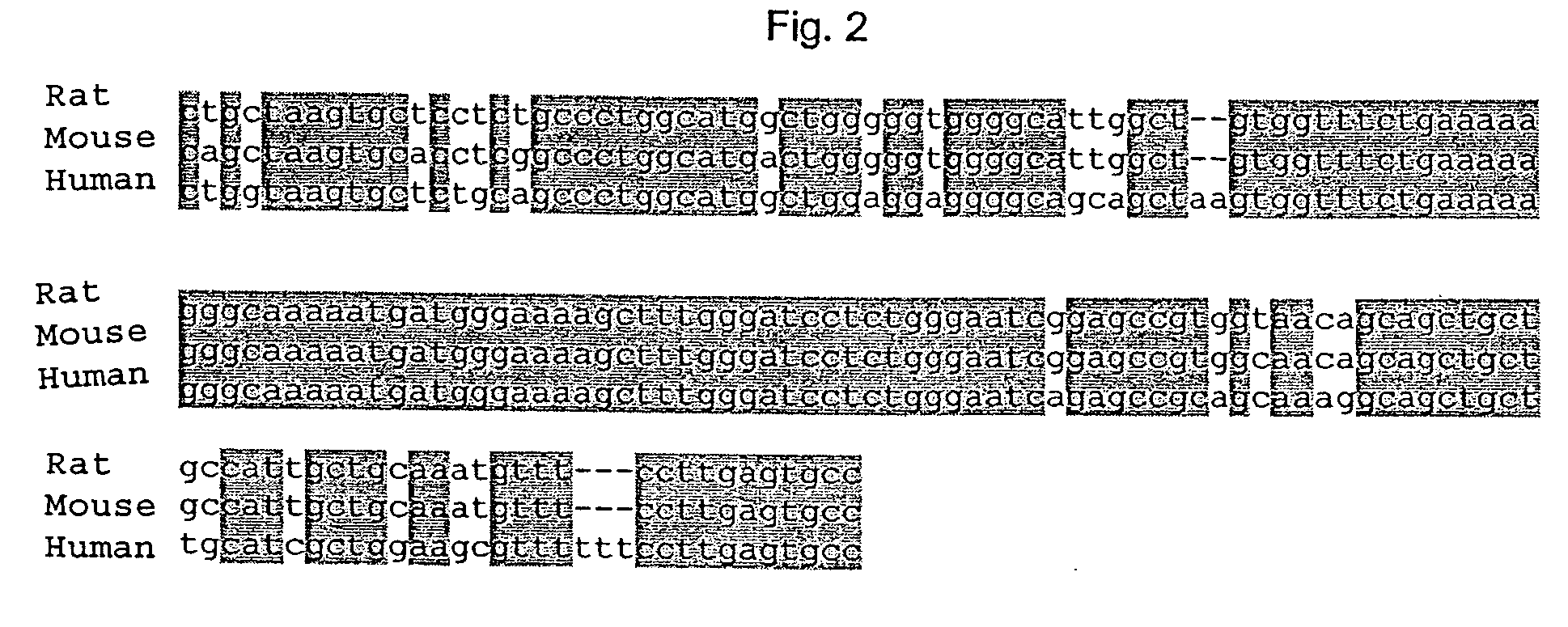Regulatory elements in the 5' region of the VR1 gene
- Summary
- Abstract
- Description
- Claims
- Application Information
AI Technical Summary
Benefits of technology
Problems solved by technology
Method used
Image
Examples
example 2
The Human VR1 Gene Contains 4 Different Exon 1 Variants
[0080] The work by Quing Xue et al. (2001, Genomics 76: 14 bis 20) describes the gene structure of the human VR1 gene and shows the location of exons 1a, 1b and 1c on the genomic DNA.
[0081] On the basis of the bioinformatic analyses of human VR1 sequences deposited in GenBank, a further exon 1 was identified in humans (FIG. 6). The section designated exon 1d is located on the genomic DNA downstream of exon 1c. Sequence comparison of the VR1 cDNAs showed that the transcripts differ only in the sequence of exon 1.
example 3
Isolation of Genomic VR1 Sequences of the Rat
[0082] Genomic DNA was isolated with the aid of the GenomeWalker Kit from Clontech. This reaction system contains four different fractions of genomic DNA fragments. Each fraction was digested with a different restriction enzyme (EcoR V, Dra I, Pvu II, Ssp I) and the DNA fragments formed were coupled with a DNA adapter. The DNA adapter contains the sequences of primers AP1 and AP2. For isolation of the sequences, the genomic DNA was amplified by means of a Nested PCR. The primers AP1 and AP2 and two gene-specific primers were used for this. A fragment 1,450 bp in size in the 5′-upstream region of exon 1a was concentrated with the aid of the primers VR1ab-35R (5′-CGAGAGTGACGGGTCGCGAAGTCAT-3′) and VR1ab-1R (5′-GACAGCACAACTCAGGCGGCTTGAA-3′) and contains the first 27 nucleotides of the RACE fragment 1ab (FIG. 3 (SEQ ID NO: 7)). Starting from the published rat cDNA (GenBank Accession Number AF029310), two overlapping fragments were amplified ...
example 4
Identification of Orthologous Sequences of Exons 1a, 1b, 1c and 1d and of the Genomic DNA 5′-Upstream of Exons 1a and 1d
[0083] The VR1 sequences deposited in GenBank were searched in respect of orthologous sequences in the mouse and in humans with the aid of the BLAST and FASTA computer programs.
1. Exon 1a and 1b
[0084] In the mouse, the exons were identified in the sequence with the databank number AL663116 [position 1308-1401 (exon 1a, 92%) and position 19656-19823 (exon 1b, 94%)]. Exon 1a is also contained in the sequence with the databank number AL670399 [position 223345-223438 (92%)]. This sequence ends upstream before exon 1b, but contains a larger region 5′-upstream of exon 1a.
[0085] The cDNAs or ESTs of the mouse which contain the VR1 exons 1a and 1b and further sequence sections of the VR1 gene are not deposited in the relevant databanks. Nevertheless, the exons were identified in the cDNA of the gene carbohydrate kinase-like (CARKL) with the databank number NM—029031 ...
PUM
| Property | Measurement | Unit |
|---|---|---|
| Dynamic viscosity | aaaaa | aaaaa |
| Dynamic viscosity | aaaaa | aaaaa |
| Dynamic viscosity | aaaaa | aaaaa |
Abstract
Description
Claims
Application Information
 Login to View More
Login to View More - R&D
- Intellectual Property
- Life Sciences
- Materials
- Tech Scout
- Unparalleled Data Quality
- Higher Quality Content
- 60% Fewer Hallucinations
Browse by: Latest US Patents, China's latest patents, Technical Efficacy Thesaurus, Application Domain, Technology Topic, Popular Technical Reports.
© 2025 PatSnap. All rights reserved.Legal|Privacy policy|Modern Slavery Act Transparency Statement|Sitemap|About US| Contact US: help@patsnap.com



